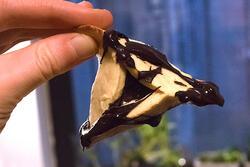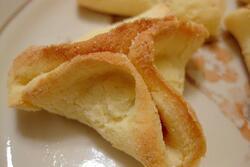Eating Jewish: Oznei Haman (Haman’s Ears)
There are many Purim sweets that are modeled after Haman's anatomy or clothing. The most popular of these are Hamantaschen (this blog has featured two great recipes this week that I definitely have to try), but in this post I want to write about the lesser known treat of Oznei Haman, also known as Haman's ears. After a bit of Internet research, I realized that many people also know Hamantaschen as Haman's ears, and thus the two are thought to be one and the same. Yet, as can be seen from my picture of this Purim dessert, they are completely different from Hamantaschen. What they consist of are fried strips of dough that have been shaped into the form of an ear and subsequently dusted with confectioner's sugar or cinnamon sugar.
Haman's ears are thought to have originated in Spain or Italy, and the first written record of the term Oznei Haman was found in an Italian Jewish comedy called Tzachut Bedichuta de-Kiddushin (An Eloquent Marriage Farce) in 1550, which was written by Judah Leone Ben Isaac Sommo of Mantua. This is the oldest Jewish play and was produced for a Purim carnival. This dessert soon spread to Jewish communities in the rest of the Mediterranean and Europe, following which various meanings were retroactively attached it. For example, a Midrash explained that the ears of Haman were "oznayim mekutafot." In turn, this phrase was translated as "clipped ears" by the scholar and poet Immanual ben Solomon, in order to suggest that Haman's ears were cut off after he was hung. However, according to Gil Marks in his Encyclopedia of Jewish Food, this was a misinterpretation that came from a similar medieval Italian practice of cutting off a criminal's ear before their execution. Rather, it more likely means "twisted ears," meaning "someone wrenched [Haman's] ears or they were deformed or twisted or triangular in shape, like those of a donkey" (248).
Haman's ears are a delicious Purim treat that are addictive in the way that most fried foods are, and made even more delectable by the sprinkling of sugar that they are coated with after being fried. The dough comes together quickly and is easy to work with when rolling out and shaping the strips of dough. When shaping the dough, this recipe instructed me to pinch the strips in the middle and twist ends so as to resemble an ear. However, I also read that the dough can be cut into small circles and the bottom of the circles can then be pinched (I saw a picture of Haman's ears shaped using this method and I think it creates a result that more closely resembles an ear). These pastries are definitely best eaten soon after they come out of the oil, when their crunchy golden exterior encases layers of warm dough. And while they can also be eaten at room temperature, when you make them I'm sure they will disappear so quickly that they won't have time to cool down.
Consuming pastries in the shape of a piece of Haman's clothing or anatomy follows from the Jewish custom of saying the phrase y'mahk shemo meaning "May his name be erased" in Hebrew, when faced with an evil person such as Haman. Thus, eating such a pastry is another way of erasing Haman's name on Purim. So grab a Haman's ear and join in this custom!
Oznei Haman (Haman's Ears)
From Gil Mark's Encyclopedia of Jewish Food
3 large eggs
3 tablespoons vegetable oil
3 tablespoons sugar
2 tablespoons rum, brandy, orange juice, orange blossom water, or water
½ teaspoon salt
2 teaspoons finely grated lemon zest or orange zest, or 1 teaspoon ground cinnamon (optional)
About 2 ½ cups all-purpose flour
Vegetable, sunflower, or peanut oil for deep-frying
About 1 cup confectioner's sugar or cinnamon-sugar for dusting
-
In a large, blend together the eggs, oil, sugar, rum (or whatever liquid you choose to use), salt, and if using zest or cinnamon. Gradually stir in enough of the flour to make a soft dough that isn't sticky. When making these I used just under two cups of flour. On a lightly floured surface, knead until smooth, about 5 minutes. Cover with plastic wrap or a kitchen towel and let stand at room temperature for at least 30 minutes.
-
Divide the dough in half. On a lightly floured surface, roll out each piece of dough into a 1/8 inch thick rectangle. With a pastry cutter or sharp knife, cut into strips 1 inch wide and 4 to 6 inches long (I cut the strips in half because I thought strips of 4 or 6 inches were a bit too long). Pinch each strip in the center and twist the ends.
-
In a deep pot, heat at least 2 inches oil over medium heat to 375 degrees.
-
In batches, fry the strips, turning once, until golden brown on both sides, about 1 minute per side. Remove with a wire-mesh skimmer or tongs and drain on a wire rack. Sprinkle generously with confectioner's sugar or cinnamon sugar. Store in an airtight container at room temperature for up to 2 weeks.








Thank you for a beautifully written, easy- to-understand explanation of this Purim treat…pockets, cookies, tri-cornered hats—let us continue to “consume our enemies” lest they consume us!! Happy Purim to you and your family!!
These never fail to delight my 23 yr old son! He will only be satisfied with a whole batch for himself! I add extra brandy and lemon zest to make more flavourful..
Another delicious Sephardic Purim treat is foulare, which is a sweet pastry that surrounds a hard-boiled egg or huevos haminados (long-cooked eggs). I definitely have to make them next Purim!
These sound too delish! You know, Morrocan Jews make all sorts of Purim treats so different than Hamantashen. I tried my hardest not to learn from my mother-in-law since I tend to eat them all up in a flash!
~Alissa
www.jewishstarjewelry.wordpress.com